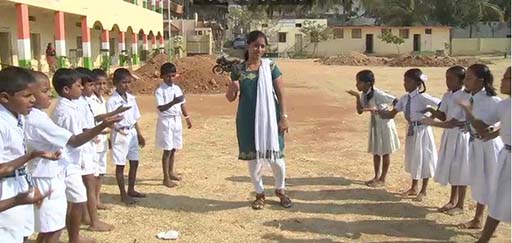2 Singing poetry
Now try this activity.
Activity 2: Singing poetry
There are many poems that are short and easy to memorise. Poems are a good way to introduce students to the sounds of language, even if the words are initially unfamiliar. This will encourage language learning in an enjoyable way. In this activity, you will choose a short poem to teach your class.
Here is a rhyme in Hindi. Can you identify the rhyming words?
Akkad bakkad bambe bo,
Assi nabbe poore sau,
Sau mein laga dhaga,
Chor nikal ke bhaga.
Now read the poems in Resource 1. You may be familiar with some of them. Read the short commentary that follows the poems.
Choose one of the poems and read it aloud to yourself. Identify the rhyming words in the poem.
Try to memorise the poem and recite it to another person. Are there actions you can put to the poem? Can you associate the poem with any movements, such as dancing in a circle?
Now choose a rhyme or a song – either one from Resource 1 or one that you are familiar with – to use with your class. Recite it or sing it with your students. You can do this outside the classroom, and put students in a large circle or in two lines (Figure 1).

Do you notice any students who have difficulty distinguishing rhyming patterns and rhyming words? Make a note of this – it may indicate a hearing impairment.
All languages have rhymes for young students. Some are funny, some are serious – and some can be a bit rude! These rhymes provide students with language experience. Because rhymes are easy to remember and recite, they build fluency and confidence in young language learners. They also build knowledge of the sounds in words – an important pre-reading skill. A student who knows rhymes in any language develops confidence, creativity and skills for language and reading.
In Case Study 1, the teacher notices that her students enjoy rhymes. She builds on this interest to develop their English.
Case Study 1: Miss Pratima uses a rhyming game for English
Miss Pratima developed a rhyming game from her textbook lesson for Class II.
I taught a textbook poem about animals. One afternoon, I saw the students playing a clapping game outside. I could hear them saying some of the words from the textbook poem. They were also saying words in English that were not in the lesson. Sometimes they were making up words that made no sense but rhymed with the English words. They were jumping up and down, clapping in a rhythm, and chanting:
‘Frog!’
‘Log!’
‘Dog!’
‘Pog!’
Their game was not part of my lesson. I thought about how I could build on their interest in playing a game with rhyming words.
The next textbook lesson was ‘What can you carry in your school bag?’ I told my class that they would play a game called ‘The Bowl that Rhymes’ based on this lesson.
I put several small objects into a bowl: a piece of chalk, a spoon, a ball, a pen, a pin and a hat. Some of the objects were in the textbook lesson. Then I explained to the students that I would say a word in English that would rhyme with one of the objects in the bowl. I said ‘moon’, and then I asked a student to take out of the bowl the object that rhymes with ‘moon’ (spoon). I continued until all the objects were selected.
The students enjoyed this game very much and wanted to play it again. Sometimes they used words in Hindi, and sometimes they used completely made-up words. I accepted this, as long as the words they came up with rhymed with the English word.
Later that week, I divided the class into small groups of four students. Each small group played ‘The Bowl that Rhymes’ using objects or picture cards.
I now try to make a short rhyming game or activity for every chapter of the English textbook to reinforce vocabulary. I have students recite rhymes in pairs and make up gestures to go with the rhymes.
Pause for thought Pratima tried out an activity based on what the students seemed to enjoy doing with language. How did she find out what they enjoy? Do you think it was a good idea for her to accept Hindi words and nonsense words from the students, as long as they rhymed with the English words? What are the benefits and possible difficulties of having students do ‘The Bowl that Rhymes’ activity in small groups? Can you identify opportunities for Pratima to evaluate students in the group activity? |
Video: Storytelling, songs, role play, drama |
1 What do pre-readers know?
